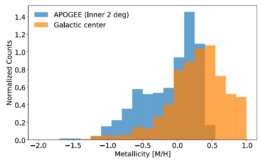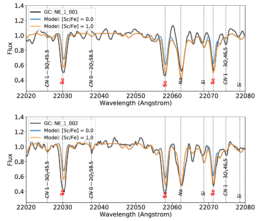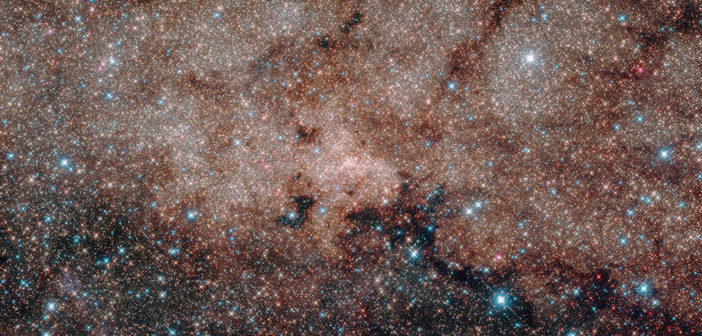Far from the galactic suburbs where the Sun resides, a cluster of stars in the nucleus of the Milky Way orbits a supermassive black hole. Can chemical abundance measurements help us understand the formation history of the galactic center nuclear star cluster?
Studying Stellar Populations

Metallicity distributions for stars in the inner two degrees of the Milky Way (blue) and the central parsec (orange). [Do et al. 2018]
Studying the chemical abundances of stars provides a way to separate distinct stellar populations and discern when and where these stars formed. Previous studies using medium-resolution spectroscopy have revealed that many stars within the central parsec of our galaxy have very high metallicities — possibly higher than any other region of the Milky Way. Can high-resolution spectroscopy tell us more about this unusual population of stars?
Spectral Lines on Display
Tuan Do (University of California, Los Angeles, Galactic Center Group) and collaborators performed high-resolution spectroscopic observations of two late-type giant stars located half a parsec from the Milky Way’s supermassive black hole.

Comparison of the observed spectra of the two galactic center stars (black) with synthetic spectra with low (blue) and high (orange) [Sc/Fe] values. Click to enlarge. [Do et al. 2018]
The features in the observed and synthetic spectra generally matched well, but the absorption lines of scandium, vanadium, and yttrium were consistently stronger in the observed spectra than in the synthetic spectra. This led the authors to conclude that these galactic center stars are unusually rich in these metals — trace elements that could reveal the formation history of the galactic nucleus.
Old Stars, New Trends?
![[Sc/Fe] trend](https://aasnova.org/wp-content/uploads/2018/03/Do18Fig4-260x131.png)
Scandium to iron ratio versus iron abundance for stars in the disk of the Milky Way (blue) and the stars in this sample (orange). The value reported for this sample is a 95% lower limit. [Do et al. 2018]
However, it’s not yet clear what could cause the elevated abundances of scandium, vanadium, and yttrium relative to other metals. Each of these elements is linked to a different source; scandium and vanadium are mainly produced in Type II and Type Ia supernovae, respectively, while yttrium is likely synthesized in asymptotic giant branch stars. Future observations of stars near the center of the Milky Way may help answer this question and further constrain the origin of our galaxy’s nuclear star cluster.
Citation
Tuan Do et al 2018 ApJL 855 L5. doi:10.3847/2041-8213/aaaec3


1 Comment
Pingback: Unusual Metals in Galactic Center Stars